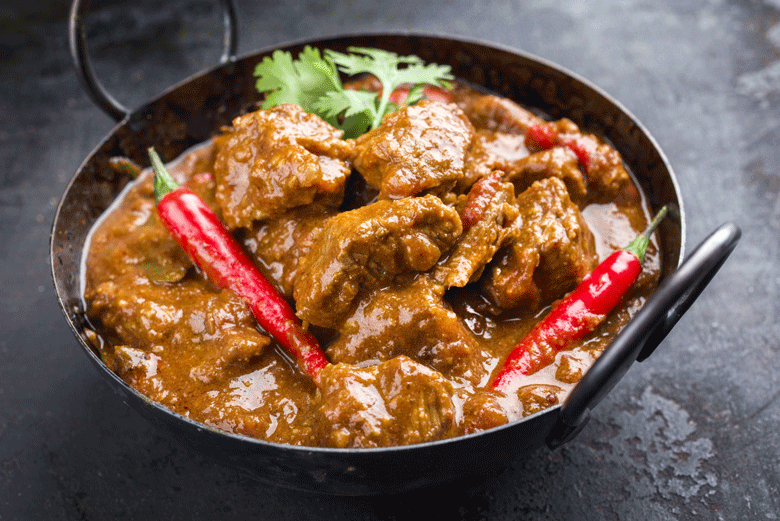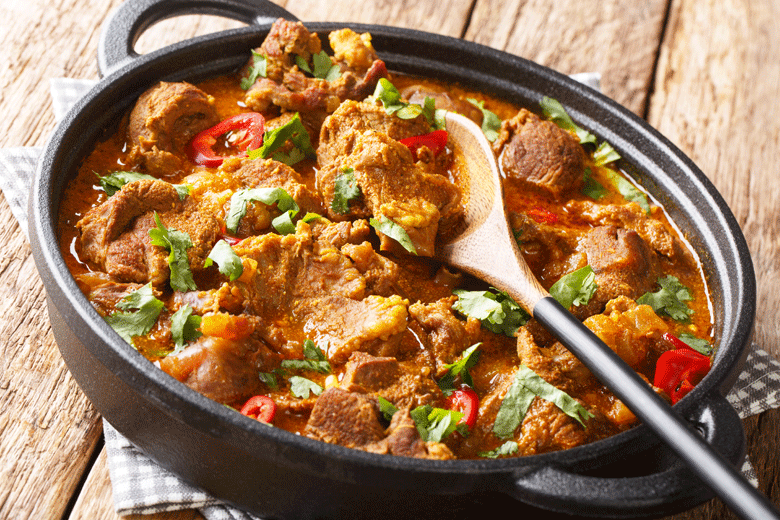 A definite must have
A definite must have
Anyone who visits Durban in South Africa must try a Durban curry. It is one of those delights in South African cuisine that should not be missed. When you eat this tender lamb curry, you will know that you are in paradise. It is comfort food of the highest order, and is hard to beat.
In South Africa, it is usually eaten with rice, chutney and sambals with a knife and fork. It may also be scooped onto a roti and eaten by hand. Another way to eat it is as a Bunny Chow. A Bunny Chow is made by removing the soft bread out of a quarter loaf of white bread, and then filling the hollowed-out crust with the curry. A Bunny Chow is eaten by initially dipping the soft bread into the curry in the crust, and is finished off by eating the crust itself, which by then has become infused with curry sauce. It is simply heavenly
eaten by initially dipping the soft bread into the curry in the crust, and is finished off by eating the crust itself, which by then has become infused with curry sauce. It is simply heavenly
Just thinking about this brought back memories of my childhood in Pinetown, just outside Durban. On a Saturday, my father would take a whole afternoon to make his special Durban curry. It was based on a recipe given to him by a South African Indian friend. It was certainly something he valued. It was as authentic as it got
To keep up the tradition, I made my dad’s Durban curry this Saturday afternoon, the way I remember him making it . I too took my time and made sure everything was done right. Each ingredient was slowly added at the right time, and I allowed enough time to ensure the curry was tender, spicy and mouthwateringly delicious.
It is not at all hard to do. Simply follow each step I took to make it, and you will never look back. Your best curry house curry will never be the same. It will just not meet the grade anymore. This will become your new favourite
Making a Durbs Curry

What did I need?
To make the curry, I needed one kilogram (slightly over two pounds) of stewing mutton. The meat was slightly fatty and had some bone in it. I also needed four medium sized onions, two green bell peppers, three cloves of garlic, a thumb sized piece of ginger, half a cup of ghee, a tablespoon of salt, 5 cloves, 10 black peppercorns, 3 teaspoons each of coriander and cumin seeds, half a teaspoon fennel seeds, 4 green cardamoms, 5 green Chillies, a teaspoon of red Chilli powder, 1 teaspoon of turmeric powder, a stick of cinnamon, 5 ripe (medium tomatoes), 2 large potatoes and a brinjal
To start, I needed to do some pre-preparation. The first thing I did was peel and finely slice the onions. That was followed by peeling the ginger and cutting it into match sticks. Next, I peeled and finely chopped the garlic, topped, sliced the green Chillies, and chopped the tomatoes and bell peppers. Finishing up on the on the vegetable  front I peeled and quartered the potatoes. I submerged them into a bowl of water, as I would only need them later. I also peeled and finely sliced the brinjal
front I peeled and quartered the potatoes. I submerged them into a bowl of water, as I would only need them later. I also peeled and finely sliced the brinjal
After cutting the mutton into bite size pieces, I placed the fennel, coriander and cumin seeds into a small pan. I toasted the spices over a gentle heat on the stove until they started to smell aromatic. From there, I placed them in a grinder and ground them into a powder.
I was now ready to start the curry. I heated the ghee in a high walled skillet until it melted. I then added the onions and sauteed them until they were becoming translucent. Next to go in was the ginger. I cooked it for about two minutes (stirring all the time) and then added the garlic. I let the garlic fry for about a minute, and then I added the green Chillies and bell peppers. After allowing them to sauté for a minute or two, I added the ground spices, the salt, cloves, peppercorns and Chilli power. I let the spices cook through, and then added the meat and brinjal. Everything got mixed well, and then I added half a cup of water so that the masalas coated the meat
After the meat was well coated by the spices, I added the tomatoes. I let everything cook at a very slow simmer until the meat was just starting to become tender and the tomatoes and brinjal had been reduced to a gravy. After that, I added two cups of water and the potatoes and covered the skillet.
Once again, I let things simmer very slowly until the meat was super tender and the potatoes were cooked. I knew the curry was ready, because red oil had collected on the surface. When the oil separates in a curry, it is always an indication that it is done.
Finally
I didn’t on this occasion, but I could have added a handful of chopped green coriander (cilantro) and a teaspoon of garum masala to the skillet in the final stages of cooking. I could also have added some chopped shallot right at the end
I served this curry with rotis and a tomato sambal and a peach & apricot chutney. The sambal was made by combining chopped tomatoes and sliced onions with a couple of chopped green Chillies with just a dash of white spirit vinegar. The chutney we used was Mrs Balls, but it would also have gone well with some mango achar or a sweet brinjal chutney
Unfortunately, we didn’t have a loaf of freshly baked bread. If we did. We all know where the curry would have gone then!
